[it]Ciao ragazzi!
Oggi comincio la recensione del mio nuovo corpo macchina, ovvero la Canon EOS 6D, la piccola fullframe che sta dando molto scalpore nel mondo per la sua grande qualità nonostante il prezzo ridotto!
La recensione verrà pubblicata in varie puntate, così da non risultare un mattone pesantissimo da leggere. In questo primo episodio analizzeremo insieme uno degli aspetti più importanti della qualità d’immagine, ovvero la resistenza ad alti ISO, che sta diventando sempre migliore man mano che la tecnologia evolve, e che ci aiuta a portare a casa scatti che prima non pensavamo nemmeno lontanamente di poter realizzare! Basti pensare a quanto è utile poter scattare a ISO 6400 senza farsi tanti problemi sul rumore quando si sta fotografando in una chiesa buia. Questo permette di poter fare foto di un matrimonio intero senza usare il flash (alcuni preti non lo gradiscono molto).
Ma veniamo al mio test. Ho posizionato la 6d su treppiede e ho fatto foto in RAW con cavo di scatto remoto dopo aver sollevato lo specchio (così da avere meno vibrazioni possibili, come nelle foto macro). Ho realizzato foto con luce naturale in casa a due libri, uno chiuso, Photoshop CS6 Classroom in a book, e uno aperto, Sketching Light di Joe McNally (trovate la recensione di entrambi alla pagina Cosa Leggo? se vi interessasse), così da poter valutare il rumore sulle zone di colore del libro chiuso e il livello di dettaglio sul testo di quello aperto. Le foto sono realizzate ad F\8 così da non avere problemi di nitidezza dell’obiettivo (per la cronaca il 24-70 f2.8 L).[/it][en]Hi guys!
Today I begin the review of my new camera body, i.e. the Canon EOS 6D, the small fullframe that is creating quite a stir in the world for its high quality despite the reduced price!
The review will be published in several posts, in order not to be a heavy to read. In this first episode we will analyze together one of the most important aspects of image quality, which is the resistance at high ISO, which is becoming better and better as the technology evolves, and that helps us to take home shots that we did not think even remotely to be able to achieve! Just think of how is useful to be able to shoot at ISO 6400 without making many problems about the noise when you are shooting in a dark church. This allows you to take pictures of an entire wedding without a flash (some priests do not like it much).
But let’s get to my test. I placed the 6d on a tripod and took pictures in RAW with cable remote shutter release after lifting the mirror (so as to have less vibration possible, as in macro photos). I made pictures with natural light in my house with two books, one closed, Photoshop CS6 Classroom in a book, and one open, Sketching Light by Joe McNally (find the review of both on the page What I read? If you are interested), so as to evaluate the noise on the color zones of the closed book and the level of detail on the text of that open. The pictures are made at F\8 in order not to have problems with sharpness of the lens (for the record, the 24-70 f2.8 L).[/en]
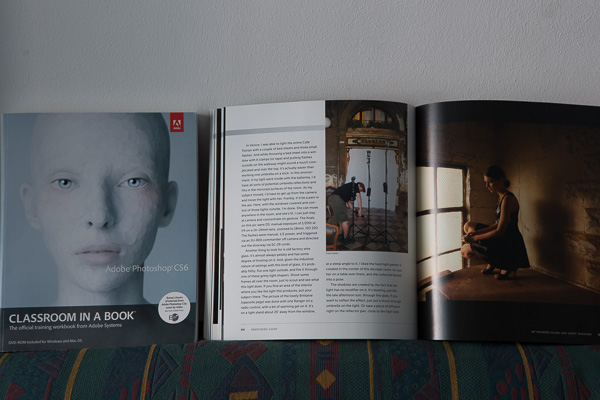
[it]Nel seguito trovate i ritagli al 100% di entrambe le zone (JPEG con qualità 100% ritagliati dal RAW originale senza alcuna modifica, nemmeno un po’ di contrasto).
Zona centrale di testo – Valutazione dettaglio
[/it][en]In the following you can find the 100% crops of both the zones (JPEG 100% quality cropped from the original untouched RAW)
Central zone of text – Evaluation of the detail
[/en]
| ISO 50 | 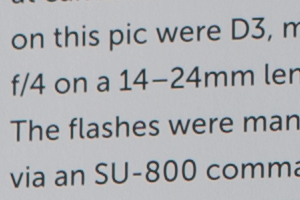 |
| ISO 100 | 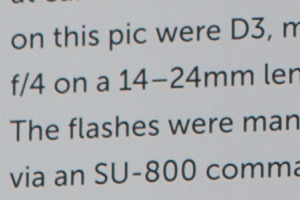 |
| ISO 200 | 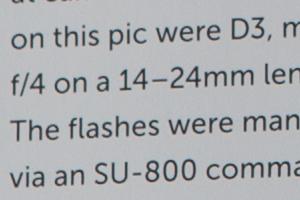 |
| ISO 400 | 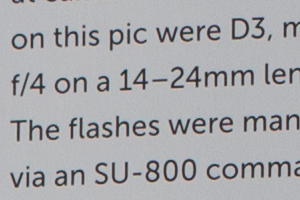 |
| ISO 800 | 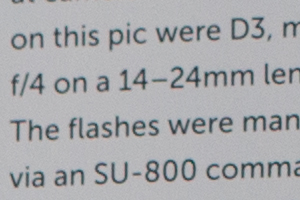 |
| ISO 1600 | 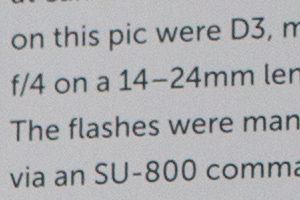 |
| ISO 3200 | 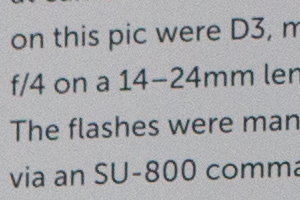 |
| ISO 6400 | 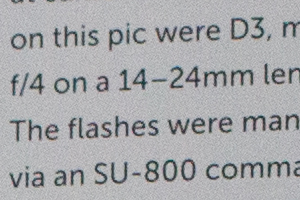 |
| ISO 12800 | 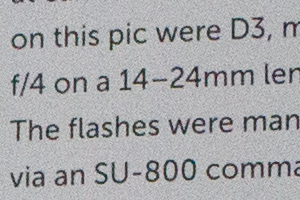 |
| ISO 25600 | 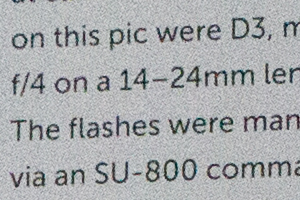 |
| ISO 51200 (H1) | 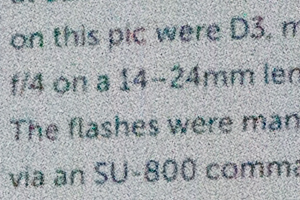 |
| ISO 102400 (H2) | 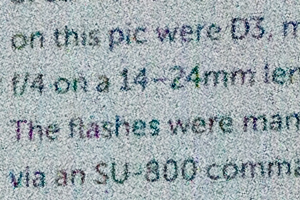 |
[it]Purtroppo il libro si è mosso leggermente ad ISO 800, oppure la messa a fuoco non è stata perfetta.. fatto sta che la foto a ISO 800 è rimasta leggermente sfuocata, ma quando me ne sono accorto ormai avevo smontato tutto. A parte ciò cerchiamo di notare come si comporta la 6d al crescere degli ISO. Fino ad ISO 1600 praticamente non c’è rumore. Ad ISO 3200 fa la sua comparsa un timido rumore, che tuttavia è molto contenuto. Tale rumore va ad aumentare a ISO 6400, sfornando comunque files ancora pienamente utilizzabili. Ad ISO 12800 e 25600 il rumore si fa vedere di più, ma tuttavia il file è ancora sfruttabile con una attenta rimozione rumore in postproduzione (nota personale: a 12800 trovo il rumore ancora piacevole, quindi non mi farei problemi a scattare a questa sensibilità, mentre a 25600 lo trovo già abbastanza invasivo, ma in caso di necessità va benissimo comunque!). Ad ISO 51200 (H1) e 102400 (H2) la foto è completamente spappolata, il rumore è veramente troppo. Nonostante ciò le scritte sono ancora leggibili, e questo non è male, significa che nell’estrema eventualità di dover realizzare una foto praticamente di notte, potremmo ancora farlo a mano libera ed ottenere sufficiente dettaglio (senza tuttavia avere qualità). Ciò può essere importante dal punto di vista giornalistico, in cui spesso avere un soggetto che si veda è di vitale importanza, e poco importa se la qualità non è ottimale.
Zona di colore uniforme – Valutazione colore
[/it][en]Unfortunately, the book has moved slightly at ISO 800, or the focus was not perfect .. the fact is that the picture at ISO 800 is slightly blurred, but when I realized I had already disassembled everything. Apart from that we try to see how it behaves 6d to grow the ISO. Up to ISO 1600 there is virtually no noise. To ISO 3200 a timid noise makes its appearance and is, however, very low. This noise increases at ISO 6400, producing files however still fully usable. To ISO 12800 and 25600 the noise is more, but however the file is still usable with a careful noise removal in post-production (personal note: I find the noise to 12800 still nice, so I would trouble shoot this sensitivity, while at 25600 I find enough invasive, but in case of need is fine anyway!). To ISO 51200 (H1) and 102400 (H2) the photo is completely crushed, the noise is too much. Despite that the writing is still legible, and this is not bad, it means that in the extreme possibility of having to take a picture almost at night, we could still do it by hand and get enough detail (although without any quality). This may be important from the standpoint of journalism, which often have a subject that you see is of vital importance, and no matter if the quality is not optimal.
Uniform color zone – Evaluation color
[/en]
| ISO 50 | 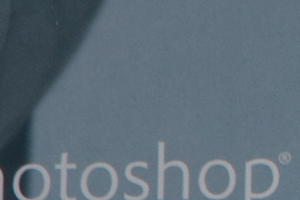 |
| ISO 100 | 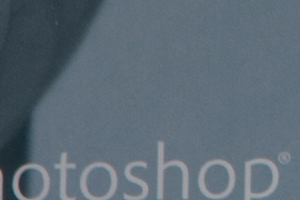 |
| ISO 200 | 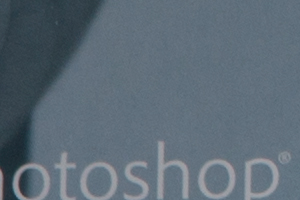 |
| ISO 400 | 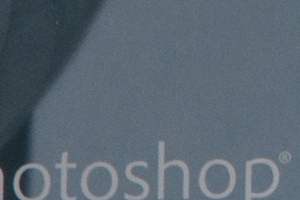 |
| ISO 800 | 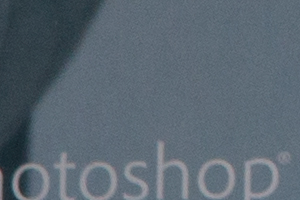 |
| ISO 1600 | 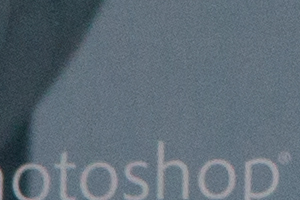 |
| ISO 3200 | 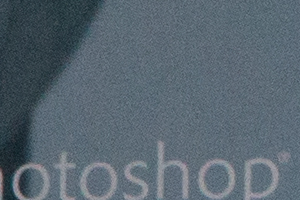 |
| ISO 6400 | 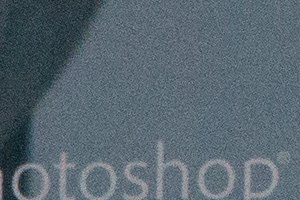 |
| ISO 12800 | 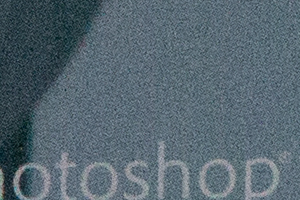 |
| ISO 25600 | 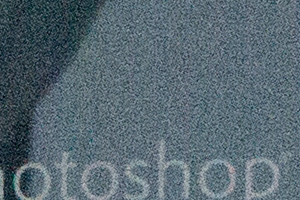 |
| ISO 51200 (H1) | 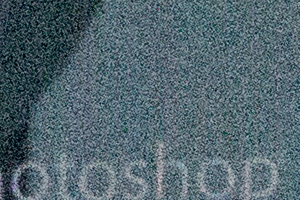 |
| ISO 102400 (H2) | 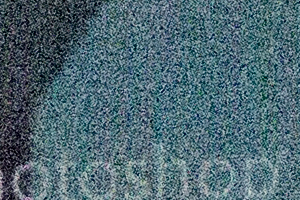 |
[it]Per quanto concerne il rumore su zone di colore uniforme, all’incirca valgono le stesse considerazioni fatte prima. Fino ad ISO 1600 il file è praticamente perfetto, mentre per sensibilità superiori il file è ancora sfruttabile pienamente solo fino a ISO 6400, massimo 12800. Oltre 12800 il rumore è veramente troppo, e difficilmente recuperabile in postproduzione. Vale ovviamente il discorso di prima, ovvero che in caso di necessità si possono usare le sensibilità altissime, a costo di una perdita veramente enorme, ma che a volte (in ambito giornalistico) è perdonata per il soggetto fotografato.
Le mie conclusioni
La 6d offre veramente una resistenza agli alti ISO invidiabile. Purtroppo non ho più la 5d mark II per confrontare la resa, ma dall’uso che ne sto facendo posso dire che gli anni intercorsi tra i due progetti si fanno sentire (come sempre nel mondo tecnologico, dove la crescita è esponenziale). Così ad occhio e a memoria posso dire che tra i due progetti c’è una distanza di uno stop (forse due), ovvero una foto fatta ad ISO 3200 su 5d mark II equivale come rumore ad una ad ISO 6400-12800 su 6d.
Da questi test e dall’esperienza sul campo che ho fatto sabato fotografando due matrimoni posso tranquillamente affermare che fino a ISO 6400 non c’è da avere alcun timore. Ad ISO 3200 e 6400 il rumore è presente, ma in maniera molto contenuta e per di più è piacevole alla vista (ci sono certi tipi di rumore che invece sono inguardabili). Le sensibilità 12800 e 25600 vanno sfruttate con oculatezza, e se possibile la 25600 è meglio non usarla proprio. Le sensibilità 51200 e 102400 sono invece completamente inutili, a meno che non dobbiate portare per forza portare lo scatto a casa, e in quel caso ovviamente rappresentano la salvezza!
Ci vediamo al prossimo episodio, in cui analizzerò altri aspetti della 6d!
Ciao!
Stefano[/it][en]With regard to the noise of areas of uniform color, roughly the same considerations made before are valid. Until ISO 1600, the file is almost perfect, while for higher sensitivity, the file is still fully usable only up to ISO 6400, maximum 12800. Over 12800 the noise is really too much, and difficult to recover in postproduction. It is valid the speech made before, i.e. that in case of need you can use the very high sensitivity, at the cost of a loss really huge, but that sometimes (in journalism) is pardoned for the photographed subject.
My conclusions
The 6d offers a truly enviable resistance at high ISO. Unfortunately I no longer have the 5d mark II to compare the yield, but with the use which I’m doing I can say that the years between the two projects are felt (as always in the technological world, where growth is exponential). To the eye and memory I can say that between the two projects there is a distance of a stop (maybe two), i.e. a photo taken at ISO 3200 on 5d mark II is equivalent to a noise like to ISO 6400-12800 on the 6d.
From these tests and field experience that I did on Saturday photographing two weddings I can safely say that up to ISO 6400 there is no fear. At ISO 3200 and 6400 noise is present, but in a much more contained and is pleasing to the eye (there are certain types of noise that are unwatchable instead). The sensitivity of 12800 and 25600 should be exploited wisely, and if possible, the 25600 is better not to use your own. The sensitivity of 51200 and 102400 are completely useless, unless you need to bring strength to bring the shot at home, and in that case obviously represents salvation!
See you at the next episode, in which I will analyze other aspects of 6d!
Bye!
Stefano[/en]

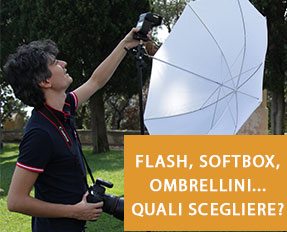
ottima recensione ste. 😉
Grazie per la recensione Stefano, attendiamo con ansia le altre puntate! 🙂
Caspita che gioiellino! Mi verrebbe voglia di fare un confronto con la mia 5D mkIII , veramente interessante il test, per le foto che faccio sono passato da 800 a 1600 iso normalmente e nn e poco riuscissi a salire…..
Sto vendendo la mark2 con 5000 scatti per la 6d , faccio bene ?
Aspetto la seconda puntata della recensione. Grazie
Non posso dirti se fai bene.. Sicuramente dal punto di vista degli ISO è una spanna sopra, anche come tecnologia in generale.. Ci sono delle mancanze però rispetto alla 5d, ma le spiegherò per bene nel prossimo episodio 🙂
Preziosissima recensione, quindi non devo star lì a rompermi la testa per cercare di fotografare a iso 100? Ottimo 🙂
Aspetto con ansia le prossime 🙂
Allora diciamo che la prima recensione ha avuto esito positivo. Good !!
http://www.stefanotealdi.com/wordpress/wp-includes/images/smilies/icon_smile.gif
Ciao alla prossima..
La 6d mi piace un sacco, gli unici difetti che le ho trovato rispetto alla 5dII sono:
-otturatore “castrato” ad 1/4000: sembra una stupidata ma usando ottiche belle luminose, beh, mi capita spesso di lavorare anche a iso 50 e 1/8000. Vero, si risolve con un ND circolare in tasca.
-Joystick: sono anni che sono abituato al joystick canon e lo trovo fondamentale, averlo inglobato nella rotellona lo trovo scomodo anche se forse è una questione di abitudine.
per il resto canon ha fatto un ottima macchina proposta ad un prezzo davvero concorrenziale. Mirino, monitor posteriore, sistema dei menù sono eccezionali.
Ciao Stefano,
scusa se intervengo sulla recensione della 6d.
Se mi puoi dare un consiglio, mi faresti una grossa cortesia al fine di risolvere un problema che penso di aver riscontrato….
Avendo letto la tua recensione mi è venuto naturale rivolgermi a te.
Da non molto ho acquistato una 6d per passare al full frame.
Ora che ho fatto poco più di 1500 scatti con la menzionata macchina, ho riscontrato il seguente tipo di problematica: non mi soddisfa affatto la separazione dei colori e anche la loro scarsa intensità. Mentre quest’ultima è regolabile a piacimento attraverso il setting di uno stile foto personalizzato, non so veramente come correggere il primo problema e per questo sono un po’ demoralizzato.
Premetto che faccio un paragone con medesimi scatti fatti con la mia vecchia 20d eseguiti con le stesse ottiche. Gli scatti eseguiti con la 20 d hanno colori più carichi e pieni (senza alcuna saturazione) e soprattutto una bella separazione cromatica; al contrario quelli fatti col la 6d hanno colori sicuramente più smorti e meno carichi ma soprattutto una deludente separazione dei colori. Spesso noto una certa predominante che, a seconda dei casi può essere rossa/gialla/blu. Se hai una mail e hai tempo e voglia, posso mandarti qualche esempio. Il mio dubbio è di aver sbagliato qualcosa circa il settaggio della macchina, che ci sia qualcosa da regolare, che non ho regolato correttamente, oppure che questa macchina abbia un difetto. Secondo te, come posso fare per capire se c’è qualcosa che non va nel setting, se la macchina ha qualche difetto oppure se quello difettoso sono io a causa della la mia scarsa familiarità con camere full frame ? Che prove o settaggi posso fare ?
Grazie mille in anticipo,
Saluti,
Marco.
ciao marco.. mi fa molto strano sentire che una 20d si comporta meglio di una 6d.. però mi viene questo dubbio: non è che ormai sei abituato ai file della 20d che erano un po’ sovrasaturi (probabilmente per un maggior contrasto applicato al file dalla reflex) e quindi ora vedi quelli della 6d (normali) come non esatti? comunque avere i colori non carichi e pieni in realtà è un vantaggio a mio parere, perchè il file è molto più lavorabile in photoshop in seguito. Infatti tantissimi professionisti seri dell’immagine preferiscono lavorare sui raw più piatti possibile, in modo da poter veramente esaltare l’immagine in postproduzione, cosa che non sarebbe possibile fare se i colori già di partenza fossero più pieni.
A mio parere devi solo abituarti alla nuova reflex, e ti direi di non modificare nulla delle impostazioni, lasciando che il file sia più piatto (e quindi con più informazione) possibile, per poi applicare contrasti e saturazioni in postproduzione che siano di tuo gusto e non di gusto della reflex 😉
ciao!
Ciao Stefano,
grazie molte della risposta.
La tua teoria può essere effettivamente corretta, ci avevo pensato anche io… Sono abituato alle caratteristiche della 20d (peraltro i risultati per me sono ancora molto buoni) e gli scatti di una macchina molto più neutra come la 6d, adeguata ad un lavoro di post produzione, potrebbero erroneamente apparirmi, non immediatamente “entusiasmanti”. Si, concordo, potrebbe essere così….
Quanto ai miei dubbi, ti posso dire che ultimamente ho fatto un migliaio di scatti in vacanza all’estero. La maggiorparte di questi, sebbene appunto “neutri” nei termini sopra descritti, li giudico accettabili. Sicuramente adatti ad un lavoro di post produzione. Ci sono però alcune singole foto (quelle per le quali ti ho scritto) che mi sembrano obiettivamente non in linea con la qualità della macchina e delle ottiche usate (sempre canon serie L). Il problema è appunto la separazione cromatica (che giudico scarsa) e la predominante di cui ti ho parlato. Forse devo stare più attento al bilanciamento del bianco ed evitare di utilizzare la funzione AWB in automatico ? Se hai una mail, ti farei volentieri vedere di cosa sto parlando.
In ogni caso, il mio testing continua, non demordo !
Grazie ancora e Saluti,
Marco.
beh io il bilanciamento del bianco automatico saranno 2 o 3 anni che non lo uso.. non mi fido per niente.. preferisco usare quelli standard che almeno sono ben tarati. Prova a scrivermi su titus27 chiocciolina gmail punto com mandandomi qualche file, così ne discutiamo per mail.. ti prego solo di mandare file leggeri perchè non ho ancora l’ADSL in casa quindi sono costretto a usare la 3G. Ciao!
Grazie mille !
nel week end se riesco ti mando qualcosa, in dimensioni ridotte….solo per capire quello di cui stavo parlando….
Grazie ancora,
Marco.
Ciao Stefano,
ti ho inviato qualche esempio di scatto con 6D (scatti nei quali ho rilevato le problematiche che ho descritto) e con 20D.
Li ho ridotti di dimensione. Il totale è circa 2 MB. Spero non sia troppo grosso.
Grazie mille per la disponibilità,
Marco.
Ciao Stefano complimenti per la recensione. Mi hai tolto gli ultimi dubbi in merito, tra un po passerò sa nikon in canon e credo che questa sia la macchina ideale. Una domanda tecnica, visto che avrei la possibilità di usare vecchie ottiche canon, che tu sappia ci sono dei problemi o la 6d è compatibile con tutti i tipi di lenti? Grazie e complimenti ancora per la recensione 🙂
la 6d è compatibile solo con ottiche EF.. magari quelle vecchie puoi usarle tramite adattatore, ma non so se convenga sinceramente..
ciao stefano, bella recensione. io ho appena acquistato la 6d e volevo chiederti sbaglio se passo a 5d mark 3. lo so l’ho appena acquistat la 6d, ma i file che sforna la mark mi sembrano molto più profondi .le fotografie chevedo fatte con questa sembrano più limpide,ricche di dettagli, più veritiere, rispetto alla 6d che mi ha un po deluso nonostante abbia ottiche buone.quindi la mia impressione riguardo la mark 3 è errata?
ciao, guarda non ho mai provato testare a fondo la 5d3 perchè non la possiedo e l’ho solo usata durante qualche workshop grazie a qualcuno che la possedeva.. quindi sinceramente non so aiutarti.. io i file della 6d li trovo veramente ottimi e lavorabilissimi, ma magari quelli della 5d3 sono meglio 🙂
Ciao, da qualche mese possiedo la 6d. Direi contento anche perché è la prima ff che possiedo. Rimango deluso e avvilito ogni volta che alzo gli iso. Anche a 1600 devo lavorare in pp per togliere il rumore che si genera con conseguente perdita di dettaglio. Ho ottiche L. E’ normale tutto ciò? Può dipendere anche dalle ottiche?
Grazie
conta che la 6d è una delle migliori a livello di rumore.. io mi trovo divinamente.. chiaro che a iso 1600-3200 c’è rumore, ma è trattabilissimo.. è impossibile avere una macchina con iso 1600 come iso 100, magari! 😀 comunque il rumore non dipende per nulla dalle ottiche, solo dal corpo macchina
Salve,
ho da un mese la 6D, ci solo arrivato dopo due anni di sogni.
Ci ho appena fatto un migliaio di scatti a Venezia usando spesso la modalità priorità di Apertura ed ISO in Automatico.
Ho riscontrato a casa nei file raw a ISO 1200, 4000 ed 8000 molta grana ingrandendo lo scatto.
Ho sbagliato qualcosa ?
È il caso per avere foto nitide e senza rumore tenerli almeno a 400 ISO e non in Automatico?
Come posso settare i vari parametri del menù ?
Ero abituato a scattare da anni con la 600D.
Uso come lenti un 24/105 f. 4 L IS USM , un 28 f. 2,8 IS USM , un 50 f. 1,8 II , un 85 f. 1,8 IS USM ed un Samyang 14 f. 2,8?che sinceramente non uso mai perché manuale.
Ci sono rimasto un po’ male in quanto ho letto che la 6D è famosa per gli scatti ad alti ISO e per qualità dei file che sforna.
Mi consigli di disabilitare il rumore per alti alti sul menù ?
Grazia e ciao.
Andrea, forse le tue aspettative erano un po’ troppo alte.. il file della 6d è meraviglioso, ma chiaramente a iso 4000 o 8000 non puoi pretendere un file pulito, lo devi pretendere lavorabile, ed è quello che ti dà la 6d. A iso 1200 chiaramente un po’ di rumore c’è, non potrebbe essere diversamente, ma comunque bisogna lavorarci un pochino, non può essere come a iso 400, sei quasi 2 stop sopra! Inoltre comincia ad avere i suoi anni, chiaramente oggi alcuni corpi macchina danno file ben migliori in termini di pulizia.. Ti suggerirei di provare a capire come lavorare bene i files ad alti ISO, perché comunque con la 6d un file a iso 1600-3200 è ancora perfettamente lavorabile e ripulibile 😉
Sto per acquistare la 6D. Ho una 7D mark 1 che terrò come secondo corpo, ed è veloce per sport e naturalistica alla luce del sole, ma non regge il rumore . Recensione e commenti di utenti mi hanno convinto, soprattutto in previsione di un viaggio invernale in Islanda (marzo). Ovviamente sarebbe meglio la 5D IV ma il costo è 3 volte quello della 6D e posso investire opportunamente in lenti adeguate al corpo macchina (attualmente ho sigma 150-600C, efs 15-75, ef 70-300, sigma 10-20, prenderei un L 24-105 usm II e in prestito un 16-13 f2.8 per poi, appena ricresce il rene, il tamron 15-30) . Che ne pensi di questa mia idea ? Intanto grazie per la recensione, che ha sciolto i miei ultimi dubbi
secondo me faresti benissimo ad attuare questa tua scelta 🙂
Buon giorno un consiglio, ho la 6d da due mesi e ho notato che in circostanza di scarsa luminosità pur puntando una luce o comunque un ambiente medio illuminato devo salire ad iso sproporzionati consigli???
comportamento normale su tutte le reflex
Buon giorno
seguo i tuoi video da diverso tempo e volevo farti i miei complimenti.
Ho acquistato da poco anche io una 6D proprio attirato dall’ottimo comportamento agli alti ISO che tutti decantano …
purtroppo però non sono per niente convinto tanto che ad un confronto con foto fatta con le mie due macchine ad ISO 800 (dove la 1100D andava già giustamente in crisi ma dove la 6D non dovrebbe avere problemi), non vedo molta differenza.
Nella foto sotto a sinistra la 6D a destra la 1100D
https://www.flickr.com/photos/62568787@N05/37421815505/in/dateposted-public/
a questo punto non saprei se potesse valerne la pena rivolgersi all’assistenza
la foto della 6d sembra abbastanza più sottoesposta rispetto a quella della 1100d, quindi è ovvio che ci sia più rumore.. gli exif sono identici? perché se non lo sono non serve a niente il confronto